Russell Letson Reviews The Million by Karl Schroeder
 The Million, Karl Schroeder (Tor 978-1-250-18542-6, $14.99, tp) August 2018. Cover by Jan Weßbecher.
The Million, Karl Schroeder (Tor 978-1-250-18542-6, $14.99, tp) August 2018. Cover by Jan Weßbecher.
Karl Schroeder’s novella The Million belongs to the future designed for his previous novel, Lockstep (2014), a setting that I still find strongly reminiscent of that branch of 1950s and ’60s SF in which One Big Idea generates a whole society (a cousin to Kingsley Amis’s “comic inferno” model). Again there is a strong dose of YA of the sort that features a displaced or disenfranchised young person facing off against the established order and uncovering various hidden political or social machineries as well as his own back-story.
There are, to be fair, probably two Big Ideas in The Million, and one enables the other. In the earlier book, the lockstep system provides a solution to the temporal and resource constraints on a spaceborne culture spread across the vast fringes of the solar system: whole population segments go into and out of hibernation according to a schedule, optimizing resource drain and keeping everyone synchronized. In The Million, lockstep is applied to the other Big Idea: the preservation of the natural and human heritages of Earth. A relative handful of families, the Million, look after the planet in real time while ten billion locksteppers sleep away the decades and awaken for one month every 30 years to enjoy the world they all share. (A distant cousin to Philip José Farmer’s Dayworld series.) The Million are the custodians of the Earth’s ecologies and cultural treasures, and in return for carrying out their duties as conservators in continuous real time, they benefit from the technologically supercharged productive capacity of a whole world and live in flamboyant, self-indulgent luxury.
There are, of course, some constraints on the Million. Population is held to the (necessarily approximate) one million, and the preservation duty is taken very seriously:
Every thirty years they were reminded of just how insignificant they could become if they were to relax their vigilance, or fail in any one of their many duties. It hung over them, never talked about, studiously ignored, that they were merely caretakers. Earth’s real owners would be back, and soon, and when they arrived, the place had better be in good condition.
Thus breeding is strictly limited and ecologies are meticulously maintained, as are frozen-in-time “museum cities” where historical buildings cannot be altered, let alone demolished. Otherwise, “[t]here were no settlements. Elephants, boars, lions, and the ancient bull of legend, the aurochs, wandered at will…. Often, nothing remained of the old towns but the cathedrals, which had been built to last.” An organization of auditors – officially the Human Sustainability Task Force – is dedicated to overseeing the treaty obligations between locksteppers and the Million, and to the policing of various matters – including the prohibitions against overpopulation and visitors and unauthorized persons remaining at large.
The upside for the Million is that single families oversee huge territories, command armies (literally so, sometimes, for war games) of robots, and are waited on hand and foot – they are even hand-sewed into their party duds by automated servants. Those parties and public events can be beyond lavish, as when the two daughters of an elite-of-the-elite family make an entrance at a gathering in Venice. What looks at first like a dancing, singing thunderhead proves to be
an airship… a floating city with towers that trailed like the tendrils of a jellyfish beneath a vast translucent sphere that must be two kilometers across…. [A]nd below were garlanded strings of color. Acrobots twirled and dove between trapezes, and a thousand more clouded around it, some shaped like fabulous glowing birds, others simply confections of radiant light.
There’s even more, climaxing with the projection of a smiley face on the moon. Even Fourmyle of Ceres’s entrance in Bester’s The Stars My Destination can’t top that one.
It is this wealth-and-luxury side that we see for much of the first third of the story, starting with young Gavin Penn-of-Chaffee monitoring a party in honor of his brother via not a “holographic projection” (because “digital simulation [is] uncouth”) but a roomful of robotic doubles that replicate the real party in complete detail, down to every raised eyebrow and sideways remark. Gavin can’t be present in person because he is not really one of the Million – he is one of those unauthorized persons, found as a small child and hidden from outside view, raised in secret as family. After the death of his adoptive father and the disgrace of his brother, he takes on the identity of an unpleasant neighbor who has opted to join the auditors, and the main story line follows this masquerade, which conceals both Gavin’s real identity and his pursuit of those responsible for the destruction of his family.
Since Gavin has been raised in isolation in the North American boonies, his adventures are also a tour of the world that lockstep has made. We see it from the viewpoint of an insider who is nevertheless also a bit of a misfit. Elana Devries-of-Balashikha, the younger daughter of one of the Hundred families – the Million’s own elite – also intends to join the auditors, an ambition approved by her family because she has “unshakable ideals” – and because they need “a spy in the machinery” to look out for their interests.
Once this pair gets to Venice to start their training as auditors, the story takes on a rather conventional YA/private-school flavor (one hesitates to make a comparison to a specific magical boarding school), with cliques and rivalries and the young protagonists pursuing their sometimes-compatible, sometimes-conflicting agendas, bending the rules, sneaking around ancient Venice, digging up secrets, and generally accomplishing more than even the pluckiest of incredibly privileged kids should be able to. This is not perhaps the strongest side of the novella, given the powers that the real rulers of their world can wield, but their unlikely success is accounted for in a resolution that opens up a larger context within which they will operate, and which suggests the possibility of future adventures, as the strains and contradictions of a lockstepped planet are elaborated.
The book’s dedication – “For Paige. Not everything’s a dystopia” – I take to be a nod to the current fashions in the YA field. Nevertheless, there is a strain of less-than-utopian darkness that runs through The Million, as it does through most of Schroeder’s exuberant, inventive, playful work, which can be characterized as adventures-in-wonderlands. Despite that darkness – the loss of loved ones, the corruptibility of entrenched powers, the threat of incursions by greedy or envious outsiders – Schroeder remains more interested in the marvels we might devise than in the ways that we might abuse them.
Russell Letson, Contributing Editor, is a not-quite-retired freelance writer living in St. Cloud, Minnesota. He has been loitering around the SF world since childhood and been writing about it since his long-ago grad school days. In between, he published a good bit of business-technology and music journalism. He is still working on a book about Hawaiian slack key guitar.
This review and more like it in the July 2018 issue of Locus.
 While you are here, please take a moment to support Locus with a one-time or recurring donation. We rely on reader donations to keep the magazine and site going, and would like to keep the site paywall free, but WE NEED YOUR FINANCIAL SUPPORT to continue quality coverage of the science fiction and fantasy field.
While you are here, please take a moment to support Locus with a one-time or recurring donation. We rely on reader donations to keep the magazine and site going, and would like to keep the site paywall free, but WE NEED YOUR FINANCIAL SUPPORT to continue quality coverage of the science fiction and fantasy field.







